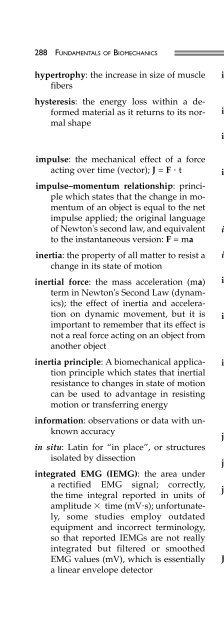Fundamentals of Biomechanics
Fundamentals of Biomechanics
Fundamentals of Biomechanics
Create successful ePaper yourself
Turn your PDF publications into a flip-book with our unique Google optimized e-Paper software.
288 FUNDAMENTALS OF BIOMECHANICS<br />
hypertrophy: the increase in size <strong>of</strong> muscle<br />
fibers<br />
hysteresis: the energy loss within a deformed<br />
material as it returns to its normal<br />
shape<br />
impulse: the mechanical effect <strong>of</strong> a force<br />
acting over time (vector); J = F • t<br />
impulse–momentum relationship: principle<br />
which states that the change in momentum<br />
<strong>of</strong> an object is equal to the net<br />
impulse applied; the original language<br />
<strong>of</strong> Newton's second law, and equivalent<br />
to the instantaneous version: F = ma<br />
inertia: the property <strong>of</strong> all matter to resist a<br />
change in its state <strong>of</strong> motion<br />
inertial force: the mass acceleration (ma)<br />
term in Newton's Second Law (dynamics);<br />
the effect <strong>of</strong> inertia and acceleration<br />
on dynamic movement, but it is<br />
important to remember that its effect is<br />
not a real force acting on an object from<br />
another object<br />
inertia principle: A biomechanical application<br />
principle which states that inertial<br />
resistance to changes in state <strong>of</strong> motion<br />
can be used to advantage in resisting<br />
motion or transferring energy<br />
information: observations or data with unknown<br />
accuracy<br />
in situ: Latin for “in place”, or structures<br />
isolated by dissection<br />
integrated EMG (IEMG): the area under<br />
a rectified EMG signal; correctly,<br />
the time integral reported in units <strong>of</strong><br />
amplitude time (mV•s); unfortunately,<br />
some studies employ outdated<br />
equipment and incorrect terminology,<br />
so that reported IEMGs are not really<br />
integrated but filtered or smoothed<br />
EMG values (mV), which is essentially<br />
a linear envelope detector<br />
interdisciplinary: the simultaneous integrated<br />
application <strong>of</strong> several disciplines<br />
to solution <strong>of</strong> a problem<br />
internal force: a force within an object or<br />
between the molecules <strong>of</strong> an object<br />
internal work: work done on body segments<br />
by internal forces (muscles, ligaments,<br />
bones)<br />
inverse dynamics: biomechanics research<br />
technique for estimating net forces and<br />
moments in a linked-segment model<br />
from measured kinematics and anthropometric<br />
data<br />
in vitro: Latin for “in glass,” or tissues removed<br />
from the body but preserved<br />
in vivo: Latin for “in the living,” or during<br />
natural movement<br />
isokinetic (“same, or constant, motion”):<br />
the condition where activated muscles<br />
create constant joint angular velocity<br />
isometric (“same, or constant, length”): the<br />
condition where activated muscles create<br />
a torque equal to the resistance<br />
torque, so there is no joint motion<br />
isotonic (“same, or constant, tension”): the<br />
condition where activated muscles<br />
work against a constant gravitational<br />
resistance; muscle tension is not constant<br />
in these conditions<br />
jerk: the third derivative <strong>of</strong> displacement<br />
with respect to time<br />
joint center: an approximation <strong>of</strong> the instantaneous<br />
center <strong>of</strong> rotation <strong>of</strong> a joint<br />
joint reaction forces: the net forces acting at<br />
joints calculated from inverse dynamics;<br />
these forces do not represent the actual<br />
bone-on-bone forces acting at<br />
joints, but a combination <strong>of</strong> bone, muscle,<br />
and ligament forces<br />
Joule: the unit <strong>of</strong> mechanical energy and<br />
work






